February 2009 Letters To The Editor
The editors of S&C invite readers to submit their opinions and information on subjects relating to technical analysis and this magazine. This column is our means of communication with our readers. Is there something you would like to know more (or less) about? Tell us about it. Without a source of new ideas and subjects coming from our readers, this magazine would not exist.
Address your correspondence to: Editor, Stocks & Commodities, 4757 California Ave. SW, Seattle, WA 98116-4499, or E-mail to editor@traders.com. All letters become the property of Technical Analysis, Inc. Letter-writers must include their full name and address for verification. Letters may be edited for length or clarity. The opinions expressed in this column do not necessarily represent those of the magazine. —Editor
Taxes and trading
 Editor,
Editor,
I have been a subscriber to Stocks & Commodities for about two years now. I find some of the articles very useful and it’s the only magazine that I actually keep in a library.
The point at which I started subscribing was about the time I switched from being an investor to a trader. I am looking for a tax service that understands that, unlike investors, traders make more than a few trades a year and who won’t run away at the sight of a trader’s ledger.
Your magazine has many great articles on trading systems, indicators, formulas for trading platforms, and so on, but just as any good trading plan has exit rules to capture winning trades or minimize losing ones, the trader needs a good plan to keep more of his hard-earned money, just like any business does. How or where does one find a Cpa who is capable of doing these kinds of tax returns? Is there software that can help?
—Rick Finkle
There are a couple of websites that I can think of that could be a starting point for you. One is TedTesser.com and the other is TradersAccounting.com. Another one listed in the Traders’ Resource database at our website, www.traders.com, is GreenTraderTax.com (Gtt). A software product listed in our Traders’ Resource to help with trade tracking for tax preparation is GainsKeeper.com. To find these and others, visit the Traders’ Resource section of our website and search on the keyword “tax.”
—Editor
SBV OSCILLATOR
Editor,
I am looking for a MetaStock formula for the Sbv oscillator (selling-buying-volume). Can you help?
—Michel Laurent, Belgium
I would suggest you direct this question to the MetaStock users group. See www.MetaStock.com. Good luck.
—Editor
TREND-FOLLOWING WITH
THE 10–40 EMA
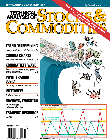 Editor,
Editor,
I read Donald Pendergast’s article in the November 2008 S&C (“The Keys To Trend-Following”) and found it very interesting. Is it possible to find out the formula for the 10–40 Ema and which software uses it? In addition, is it possible to use the 10–40 Ema with a daily time frame and the forex markets?
—Ugo Sabadini
Don Pendergast replies:
The formula was given in the article: Simply buy on the first daily close after a weekly 10–40 Ema cross to the upside. Sell on the first daily close after a weekly 10–40 Ema cross to the downside.
Here’s the MetaStock code for the 10–40 Ema crosses only:
ENTRY Signal: Cross( Mov( C,10,E), Mov( C,40,E)) EXIT Signal: Cross(Mov(C,40,E),Mov(C,10,E))
Hope this helps. Thank you for the kind remarks about my article! Please visit my website at www.chartw59.com; you may find some of the charts and commentary beneficial to you.
Logarithmic paper
 Editor,
Editor,
Do you know where I could buy logarithmic charting paper? I used to be able to buy it 20 years ago by mail, including a chart book to protect it. As I recall, it was 11 x 17 inches, or something similar. It had a separate scale at the bottom for charting volume using an arithmetic scale. If you could direct me to a supplier, I would really appreciate it. Thanks.
—Allen Bains
I know some of our readers out there still use charting paper and could tell you where to get it. How about it, readers?
—Editor
Which Is Which?
Editor,
I picked up a copy of Stocks & Commodities recently and found a reference to a publication called Working Money, which isn’t carried at my bookstore. I called your circulation department and found out it’s only available online. Then I saw a reference to a publication called Traders.com Advantage, and discovered that was only available online too. And then I heard about Traders.com, which is available in print, but it’s not Traders.com Advantage. How many publications do you have? I just want to find out more about the markets!
—John Arlen
 Stocks & Commodities is our flagship print publication. Working Money and Traders.com Advantage (Tca) are our online publications aimed toward real-time traders; and Traders.com is our bimonthly print publication that uses reprinted material from Tca. Thanks for asking!
Stocks & Commodities is our flagship print publication. Working Money and Traders.com Advantage (Tca) are our online publications aimed toward real-time traders; and Traders.com is our bimonthly print publication that uses reprinted material from Tca. Thanks for asking!
—Editor
Heikin-Ashi-based oscillator
 Editor,
Editor,
I very much enjoyed the article “Trading With The Heikin-Ashi Candlestick Oscillator” by Sylvain Vervoort in the December 2008 issue and am still studying it.
When I first came across the heikin-ashi technique a few years ago, I was immediately attracted to its potential vis-à-vis its simplicity. Since Vervoort seems to be seriously interested in the heikin-ashi technique, I would like to share with him (and other readers) a heikin ashi—based oscillator that I have created (the MetaStock code is shown below) and suggest that he consider improving/building on it and perhaps run some long-term and thorough backtests on, for instance, the Standard & Poor’s 500 and sector indexes Etfs (Spy, Xlf, Xli, Xlk, etc) to assert its usefulness.
{Heikin-Ashi Counter}
period:=Input(“Periods”,5,100,12);
haclose:=(O+H+L+C)/4;
haopen:=(PREV+Ref(haclose,-1))/2;
hahigh:=Max(Max(H,haopen),haclose);
halow:=Min(Min(L,haopen),haclose);
counter:=If(hahigh>Ref(hahigh,-1) AND
halow>Ref(halow,-
1),1,If(hahigh<Ref(hahigh,-1) AND
halow<Ref(halow,-1),-1,0));
indic:=Sum(counter,period)/period*100;
indic;
—Name Withheld
Sylvain Vervoort replies:
I am providing some test results for your heikin-ashi counter formula. [See Figures 1 and 2.—Editor]
Getting positive results from using any single indicator is not easy. Either you have to create crossovers using an additional average or smooth it so much that it would be possible to trade on the turning points. Both of these methods create too much delay to make it an automatic, profitable system. Another method would be to use certain oscillator levels as buying and selling references, but in that case you must have an oscillator that attains highest and lowest levels a lot of the time.
So I tested the latter using your formula with just five days’ counting. The test formula is as follows:
period:=5; haclose:=(O+H+L+C)/4; haopen:=(PREV+Ref(haclose,-1))/2; hahigh:=Max(Max(H,haopen),haclose); halow:=Min(Min(L,haopen),haclose); counter:=If(hahigh>Ref(hahigh,-1) AND halow>Ref(halow,- 1),1,If(hahigh<Ref(hahigh,-1) AND halow<Ref(halow,-1),-1,0)); indic:=Sum(counter,period)/period*100; buy:=indic>-20; sell:=indic<-20;
Each stock has $1,000 to start with and there is no profit or loss sharing with the other stocks. Further, we are going long only. I get a 70% profit with an average of 68 trades per stock (inclusive of brokerage commissions) using 57 Dutch midcap stocks, from the beginning of 2003 until the end of December 2008. Considering the current situation, this result is certainly not bad. Results from a buy & hold approach will probably be negative these days. If I run the same test using the same starting date but stopping at August 2007, I get a profit of 144% with an average of 46 trades. (See Figures 1 and 2.)
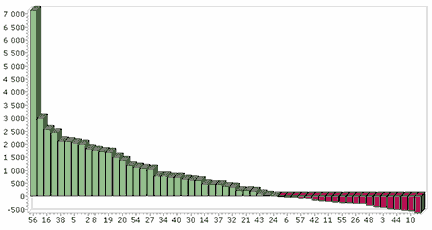
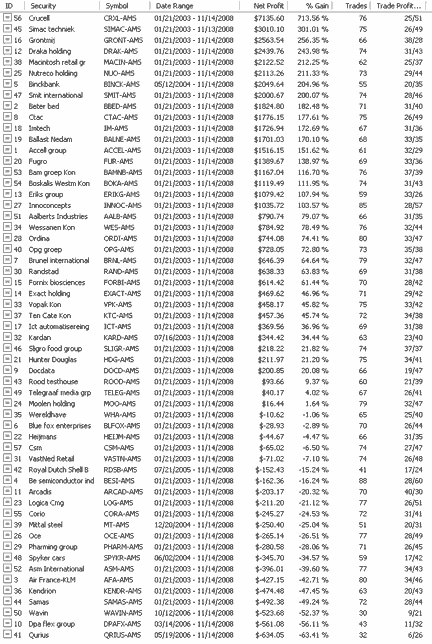
FIGURE 1: HEIKIN-ASHI COUNTER FORMULA. Each stock starts with $1,000, and there is no profit or loss sharing with the other stocks, and going long only. The trader gets a 70% profit with an average of 68 trades per stock (inclusive of brokerage commissions) using 57 Dutch midcap stocks, from the beginning of 2003 until the end of December 2008. The results are not bad, considering the current economic situation.
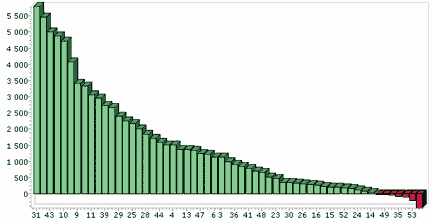
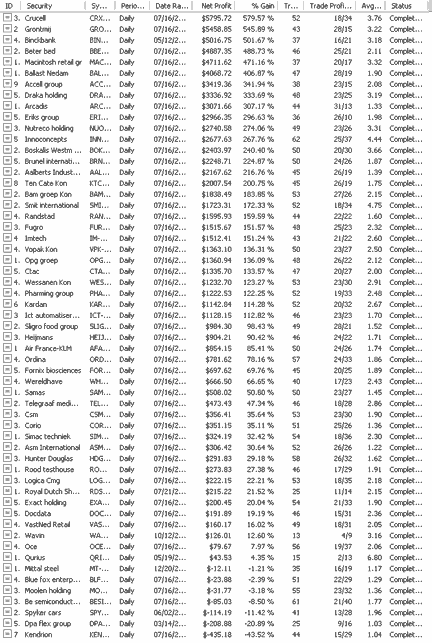
FIGURE 2: HEIKIN-ASHI COUNTER FORMULA. Running with the same starting date but stopping at August 2007, the profit result is 144% with an average of 46 trades.
You can probably experiment further with the formula and try other markets. I get slightly better results, with only about half the number of trades, if I use the heikin-ashi closing price average as a reference (all heikin-ashi price levels divided by 4) that I normally use.
List Of Technical Analysis Products
Editor,
I just completed submitting my votes for the Readers’ Choice Awards. May I ask a favor of you? Is it possible for you to resend me the lists of platforms, softwares, brokers, and trading systems that I just voted on, as I have never before seen such a comprehensive list, and it would be a great resource for me. I meant to copy them after voting but did not realize this would not work. Thank you.
—Tamer El-Kamel
Thank you for the email. We’ve just added the ballot without the voting functionality to our website for just this purpose. You can view it from the following web page:
https://technical.traders.com/Products/rcaballot.asp
—Editor
Always a delight
Editor,
Don Bright, Daryl Guppy, & Tom Busby are always a delight. Best regards!
—Name Withheld
Glad you like their work! For those readers who may not be familiar with those writers, just take a look at our website at Traders.com and do a search to see what they’ve written over the years.
Don Bright, for instance, writes a monthly column titled “Since You Asked,” in which he answers questions about trading. He also writes incidental articles from time to time, like he did in “The Russell Reconstitution: Plan For 2008” for the March 2008 issue; and “The Business Of Trading” in the August 2008 issue.
Daryl Guppy is the author of a number of books and has also written articles for us. Last year, he wrote a two-parter, “True Price Value” with cowriter Chen Jing in April 2008 and “Parallel Listings And True Price Value” in May 2008.
Tom Busby was interviewed for our June 2008 issue (“Trading And Teaching: Tom Busby”), and he has written articles for us in the past, including “Single-Stock Futures” in the April 2002 issue and “Trading In The 21st Century” in the August 2002 issue.
—Editor